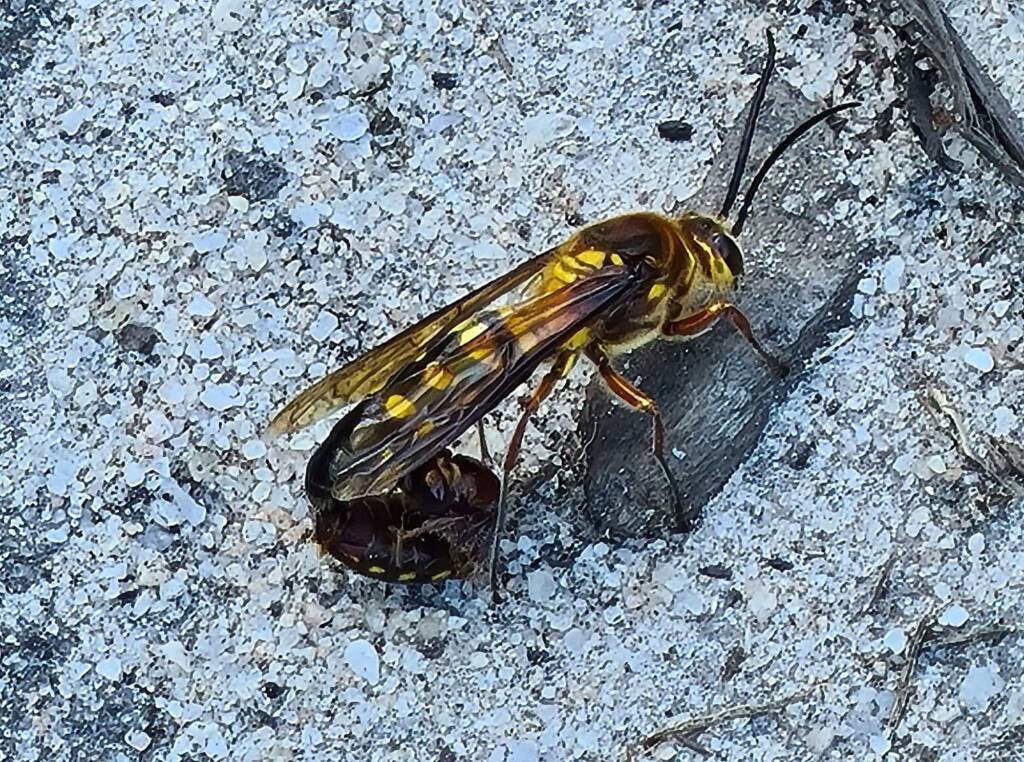— see Blue Hairy Flower Wasp | Hairy Flower Wasps | Tiphiid Flower Wasp (family Tiphiidae)
So what is in a name… the Australian Flower Wasps, a generic common name given to a group of amazing insects with current count of 600 named Flower Wasp species and more then 2,000 undescribed species, which also point to the fact that there are as many unrecognised genera.
Not be confused with the Hairy Flower Wasps (family Scoliidae), the family Tiphiidae, subfamily Thynninae, commonly referred to as Thynnidae (also Smooth Flower Wasp), are a large group of solitary wasps, whose species are mainly small, and up to 30 mm long.
Some of the female wasps of subfamilies (all Diamminae, Methochinae, and Thynninae) are wingless, and search for ground-dwelling beetle larvae, or (in one species) mole crickets, as the prey to feed their larvae. The larvae are almost universally parasitoids of various beetle larvae, especially those in the superfamily Scarabaeoidea.
Pictured here are mating Thynnid Wasps. The smaller wasp is the female and the larger wasp is the male.

If you want to learn more about how to identify the Flower Wasps, check out the wonderful article “Getting to know flower wasps” by Kerri-Lee Harris (from Life In A Southern Forest). Beautifully written and presented, we quote from the article:
Australian flower wasps belong to the subfamily Thynninae. Until recently, Thynninae was a subfamily of Tiphiidae. However, Thynninae has been moved into a new family, Thynnidae, on the basis of molecular evidence (ref. 8). There is still a family called Tiphiidae, but it now includes only one Australian species. Confused? Rest assured you are not alone. Even major data systems are at odds. Neither the Australian Faunal Directory nor ALA reflect the change, but iNaturalist does.
Getting to know flower wasps by Kerri-Lee Harris, Life In A Southern Forest1

All species of Thynnid Wasps are parasitoids (their larvae feed on and eventually kill their host). The female searches for a host to lay her egg in. The female thynnid needs to first mate, and what is unusual with Thynnid Wasps, is that there appears to be a unusually high number of cross-species mating.
…a female thynnid can only feed in copulo. If a female fails to attract the right male, it’s possible that she subtly changes the chemistry of her pheromone trail to pick up anyone who may be around. She gets fed and it’s possible that, recognising the mismatch, she rejects the male’s sperm but lays unfertilised but viable eggs anyway, giving rise to larvae that are clones of herself. There is a suspicion that something like this is involved because, even though extra-species couplings are known to happen quite a lot, true hybrid wasps are rarely found.
Thynnids are seriously sexy wasps, Kevin Thiele, Taxonomy Australia2

Following pictures are two mating Thynnid Wasp (the larger being the male and the smaller curled ball shape is the female). These mating Flower Wasps were photographed on a sandy track in a paddock in Gippsland, Victoria.


Check out some of our listed Hairy Flower Wasps:
- Blue Hairy Flower Wasp (genus Austroscolia)
- Yellow Hairy Flower Wasp (Radumeris radula)
- Yellow Hairy Flower Wasp (Radumeris tasmaniensis)
and our blog My yellow hairy bug…
- Scientific classification
- Kingdom: Animalia
- Phylum: Arthropoda
- Subphylum: Hexapoda
- Class: Insecta
- Informal: Pterygotes
- Order: Hymenoptera
- Superfamily: Vespoidea
- Family: Tiphiidae
- Subfamily:
- Anthoboscinae
- Diamminae
- Methochinae
- Myzininae
- Thynninae
Footnote & References
- Getting to know flower wasps, by Kerri-Lee Harris, 27 October 2020, Life In A Southern Forest (biodiversity & ecology in the Australian bush), https://southernforestlife.net/happenings/2020/10/flower-wasps
- Thynnids are seriously sexy wasps, Kevin Thiele, 22 February 2019 / updated 19 March 2019, Taxonomy Australia, https://www.taxonomyaustralia.org.au/post/thynnids-are-seriously-sexy-wasps
- Thynninae, Atlas of Living Australia, https://bie.ala.org.au/species/https://biodiversity.org.au/afd/taxa/8c7daf99-6f76-4d84-96d9-31a37ea4e599
- Thynnid Flower Wasps (Family Thynnidae), iNaturalistAU, https://inaturalist.ala.org.au/taxa/605157-Thynnidae
- Subfamily Thynninae, The Field Guide to the Insects of Tasmania, https://tasmanianinsectfieldguide.com/hexapoda/insectsoftasmaniahymenoptera2/superfamily-vespoidea-2/tiphiidae-flower-wasps/subfamily-thynninae/
WaspsWasps Index Australian Large Wasps Australian Mud Nest Wasps Mud Wasp Velvet Ants Abispa ephippium Acarozumia amaliae Aulacidae Australodynerus Bembix Bembicinae Blue Hairy Flower Wasp Braconidae Chrysididae Cryptocheilus bicolor (Orange Spider Wasp) Delta latreillei (Potter Wasp) Eumeninae Ferreola handschini (Orange-collared Spider Wasp) Flower Wasps Gasteruptiid Wasp Hairy Flower Wasps Isodontia (Grass-carrying Wasp) Lissopimpla excelsa (Orchid Dupe Wasp) Mutillidae Paralastor sp. Pseudabispa bicolor ssp. nigrocinctoides Radumeris radula (Yellow Hairy Flower Wasp) Radumeris tasmaniensis (Yellow Hairy Flower Wasp) Sceliphron laetum Thynnid Wasps Tiphiidae Yellow and Black Wasp
InsectsBees Beetles Blattodea Butterflies Coleoptera Cicada Crabronidae Diptera Dragonflies & Damselflies Formicidae Hemiptera Heteroptera (True Bugs) Mango Planthopper Moths Orthoptera Orthopteroid Processionary Caterpillar Stink Bugs, Shield Bugs and Allies Syrphidae Wasps Water Scorpion (Laccotrephes tristis) Witchetty Grub
